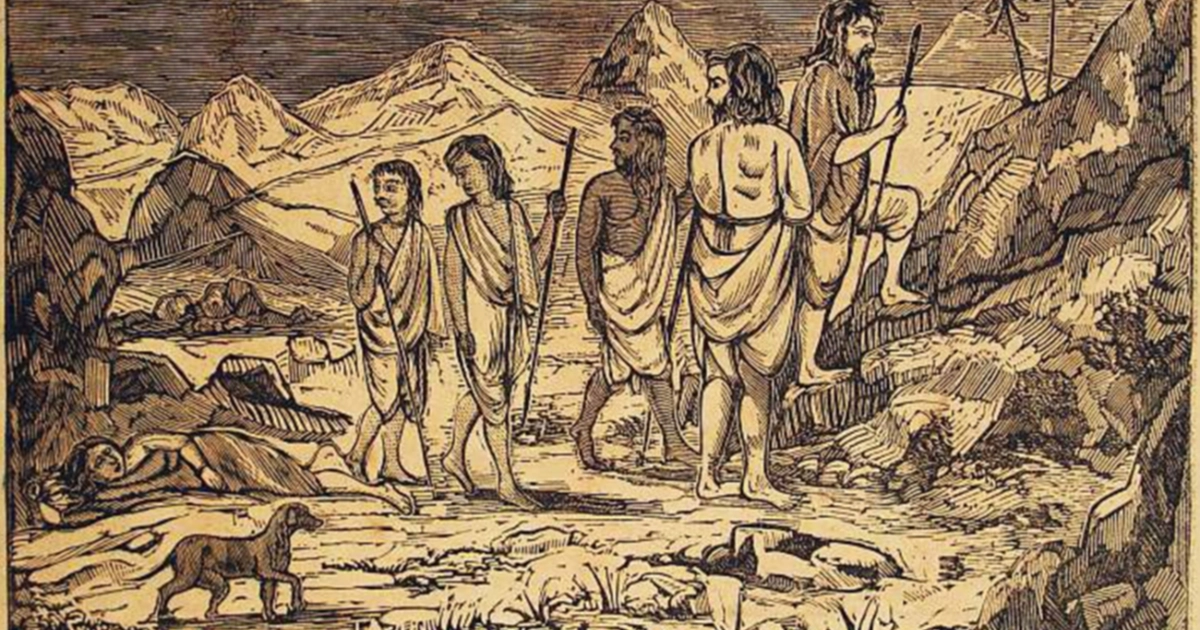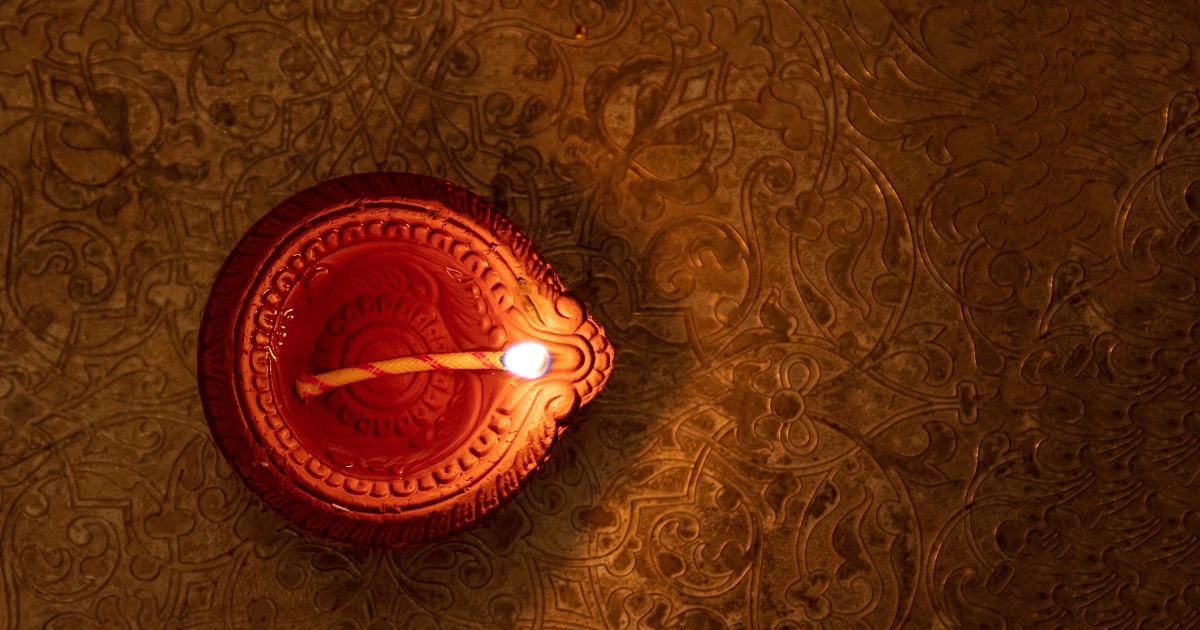In the vast cosmology of the Itihāsa and Purāṇa, Dharma is more than a metaphysical principle and eternal law — he is also physically personified as Dharmadeva, the divine embodiment of cosmic law, moral order, and even worldly prosperity. His life and deeds, as preserved in multiple texts, reveal a complex deity who governs not only justice but also the fabric of social and familial values.
Avatāras
According to the Mahābhārata, Dharmadeva was not born through ordinary means. He emerged from Brahmā’s right nipple:
sthānaṃ tu dakṣiṇaṃ bhitvā
brahmaṇo naravigrahaḥ |
niḥsṛṭo bhagavān dharmaḥ
sarvalokasukhāvahaḥ ||
Ādi Parva, Chapter 65
He took the form of a human and came to be known as the one who brings happiness to all worlds. He had three sons:
- Śama
- Kāma
- Harṣa
These sons are described as beings of immense energy who charm and sustain all creation. They too had consorts:
- Śama married Prāptī
- Kāma married Ratī
- Harṣa married Nandā
Consorts
Dharmadeva is depicted as a deity who marries multiple daughters of Dakṣaprajāpati, each symbolizing a moral or mental virtue. According to the Bhāgavata Purāṇa (Navama Skandha), he married thirteen daughters of Dakṣa: Śraddhā, Maitrī, Dayā, Śānti, Puṣṭi, Tuṣṭi, Kriyā, Unnati, Buddhi, Medhā, Titikṣā, Hṛī, and Mūrti.
In addition, he married ten more women — Bhānu, Lambā, Kukubh, Jāmi, Viśvā, Sādhyā, Marutvatī, Vasu, Muhūrtā, Saṅkalpā — and Sunṛtā. The Mahābhārata adds more names: Kīrti, Lakṣmī, Dhṛti, Medhā, Puṣṭi, Śraddhā, Kriyā, Buddhi, and Lajjā.
From each of these divine unions, progeny representing values, virtues, and cosmic forces were born:
- Śraddhā → Śubha
- Maitrī → Prasāda
- Dayā → Abhaya
- Śānti → Sukha
- Tuṣṭi → Moda
- Unnati → Darpa
- Buddhi → Artha
- Medhā → Sukṛti
- Titikṣā → Śama
- Hṛī → Praśraya
- Mūrti → Nara and Nārāyaṇa
- Sunṛtā → Satyavrata and Satyasena
Of these, Satyasena is noted for destroying Yakṣas and demons. Some of his other notable descendants include:
- Ṛṣabha and Vidyotana (from Lambā)
- Saṅkaṭa → Kīkaṭa and Durgadeva (from Kukubh)
- Svarga → Nandī (from Jāmi)
- Viśvadevas (from Viśvā)
- Sādhyas (from Sādhyā, different from those of Brahmā)
- Jayanta and Marutvat (from Marutvatī)
- Aṣṭavasus (from Vasu), the first being Droṇa, who married Abhimati (Dharā); they were later born as Nandagopa and Yaśodā.
Hari, Kṛṣṇa, Nara, and Nārāyaṇa
Among the most revered offspring of Dharma are:
- Hari and Kṛṣṇa – yogis of supreme spiritual stature
- Nara and Nārāyaṇa – great ascetics and partial incarnations of Viṣṇu, renowned for their penance in Badarikāśrama.
These figures are central to the Itihāsa and Purāṇa tradition and are considered divine expressions on Bhūloka.
Dharmavratā
Dharmadeva’s daughter Dharmavratā, born of Dharmavatī, is a model of purity and ascetic virtue. Married to the sage Marīci, she once attended to Brahmā while Marīci slept. Misunderstanding her devotion, Marīci cursed her to become a stone. Dharmavratā undertook penance in fire for ten thousand years. The gods, pleased with her, declared that devas would henceforth reside in the stone — now called Devaśilā, still worshipped today.
Dharmadeva’s Avatāras
Dharmadeva takes various avatāras as seen across our Itihāsa and Purāṇa - in order to guide, or protect:
- Yudhiṣṭhira, son of Dharma and Kuntī, is the human embodiment of Dharma.
- Dharma performs penance in Dharmatīrtha and along the Vaitaraṇī River.
- As a deer, he steals a brahmin’s araṇi sticks, initiating a dialogue.
- As a Yakṣa, he tests the Pāṇḍavas at the forest pond.
- Disguised as Vasiṣṭha, he visits Viśvāmitra.
- On Brahmā’s command, he binds daityas and dānavas and presents them to Varuṇa.
- Dharma worships a brahmin named Satya by appearing as a deer.
- He tests Sudarśana by appearing as a brahmin.
- He saves Sage Vatsanābha from a storm, appearing as a buffalo.
- He imparts spiritual counsel to Janaka Maharājā in disguise.
- He enters Kāmadhenu’s milk as Anger to test Jamadagni’s calmness.
- And quite well-known, he accompanies the Pāṇḍavas as a dog on their final journey to heaven.
In one episode, Dharma is cursed by Sage Aṇimāṇḍavya to be born as Vidura, the wise and dharmic minister of the Kuru court. These are a few of the many mentions in the Itihāsa-Purāṇas.
Dharma and Kāla (Yama)
Many texts and traditions conflate Dharma with Kāla or Yamarājā, due to their shared titles:
- Dharmarāja
- Yama
- Daṇḍadhāra
- Vaivasvata
However, they are distinct beings. Dharmadeva is son of Brahmāji, and has descendents like Yudhiṣṭhira. On the other hand, Kāla (Yama): Son of Sūrya and Saṃjñā, no children, ruler of Kālapurī, judge of the dead.
The confusion arises because Yama, also known as Kāla, and the accountant of puṇya and pāpa karma, is also called Dharmarājā.
Dharmadeva earns the name because he is Dharma itself. The name Yama for Dharmadeva refers not to the deity of death, but to self-control, one of the meanings of the Saṃskrta word yama.
Conclusion
Dharmadeva is a deity of virtue, a guardian of order, a progenitor of moral values, and a compassionate guide. Through his myriad marriages, offspring, avatāras, and tests, he weaves a profound narrative of how dharma governs not just law or justice, but the very spirit of life, society, and liberation.
To understand Dharmadeva is to recognize that in the Indic worldview, ethics is divine, and divinity is ethical.







